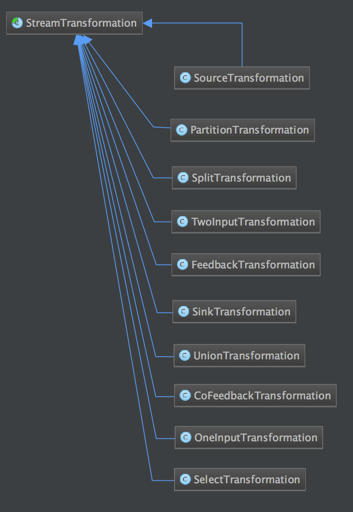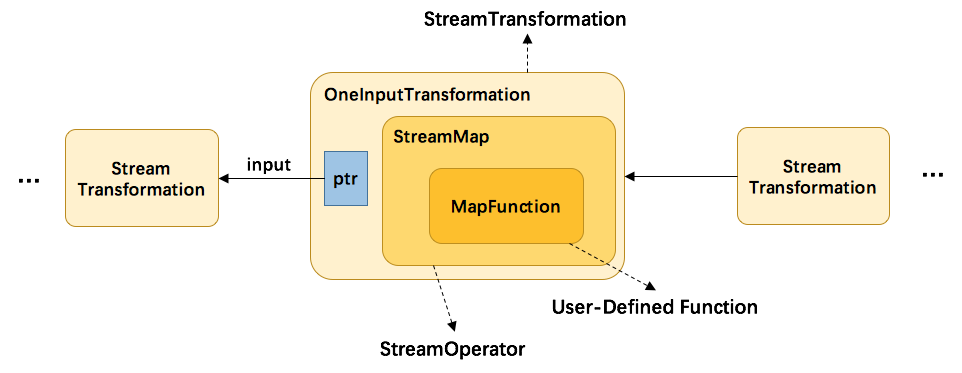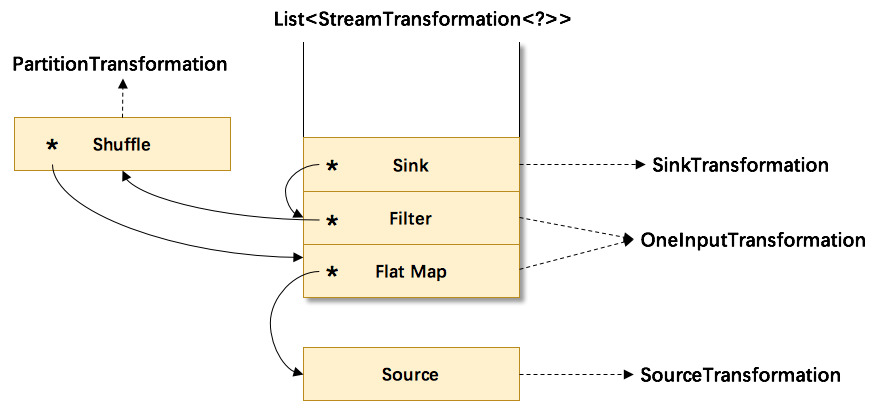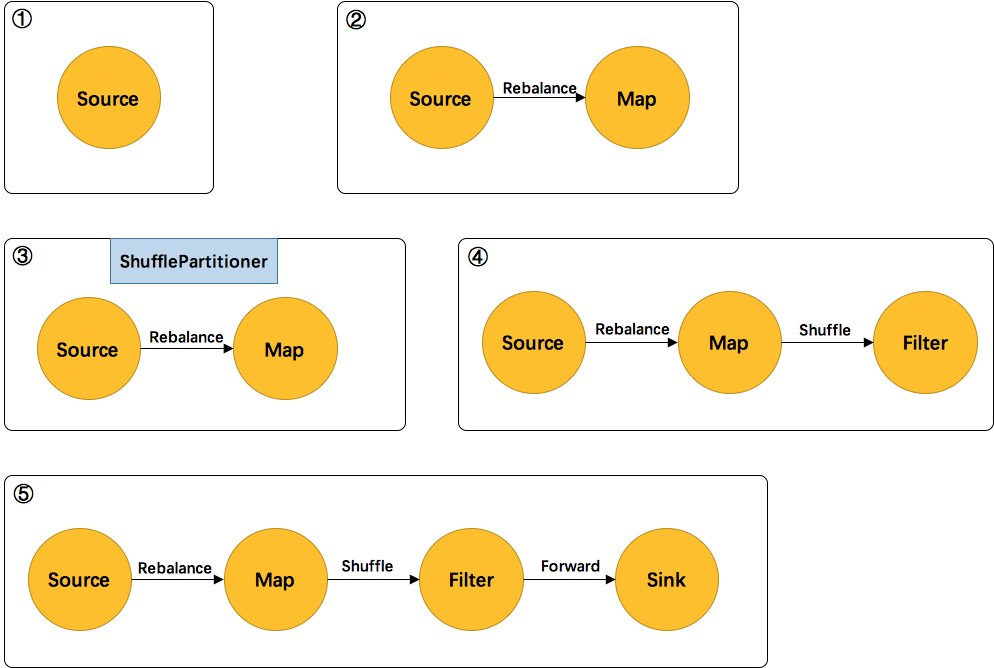继上文Flink 原理与实现:架构和拓扑概览中介绍了Flink的四层执行图模型,本文将主要介绍 Flink 是如何根据用户用Stream API编写的程序,构造出一个代表拓扑结构的StreamGraph的。
StreamGraph 相关的代码主要在 org.apache.flink.streaming.api.graph 包中。构造StreamGraph的入口函数是 StreamGraphGenerator.generate(env, transformations)。该函数会由触发程序执行的方法StreamExecutionEnvironment.execute()调用到。也就是说 StreamGraph 是在 Client 端构造的,这也意味着我们可以在本地通过调试观察 StreamGraph 的构造过程。
Transformation
StreamGraphGenerator.generate 的一个关键的参数是 List<StreamTransformation<?>>。StreamTransformation代表了从一个或多个DataStream生成新DataStream的操作。DataStream的底层其实就是一个 StreamTransformation,描述了这个DataStream是怎么来的。
StreamTransformation的类图如下图所示:
DataStream 上常见的 transformation 有 map、flatmap、filter等(见DataStream Transformation了解更多)。这些transformation会构造出一棵 StreamTransformation 树,通过这棵树转换成 StreamGraph。比如 DataStream.map源码如下,其中SingleOutputStreamOperator为DataStream的子类:
/**
* Applies a Map transformation on a {@link DataStream}. The transformation
* calls a {@link MapFunction} for each element of the DataStream. Each
* MapFunction call returns exactly one element. The user can also extend
* {@link RichMapFunction} to gain access to other features provided by the
* {@link org.apache.flink.api.common.functions.RichFunction} interface.
*
* @param mapper
* The MapFunction that is called for each element of the
* DataStream.
* @param <R>
* output type
* @return The transformed {@link DataStream}.
*/
public <R> SingleOutputStreamOperator<R> map(MapFunction<T, R> mapper) {
TypeInformation<R> outType = TypeExtractor.getMapReturnTypes(clean(mapper), getType(),
Utils.getCallLocationName(), true);
return transform("Map", outType, new StreamMap<>(clean(mapper)));
}@PublicEvolving
public <R> SingleOutputStreamOperator<R> transform(String operatorName, TypeInformation<R> outTypeInfo, OneInputStreamOperator<T, R> operator) {
// read the output type of the input Transform to coax out errors about MissingTypeInfo
transformation.getOutputType();
// 新的transformation会连接上当前DataStream中的transformation,从而构建成一棵树
OneInputTransformation<T, R> resultTransform = new OneInputTransformation<>(
this.transformation,
operatorName,
operator,
outTypeInfo,
environment.getParallelism());
@SuppressWarnings({ "unchecked", "rawtypes" })
SingleOutputStreamOperator<R> returnStream = new SingleOutputStreamOperator(environment, resultTransform);
// 所有的transformation都会存到 env 中,调用execute时遍历该list生成StreamGraph
getExecutionEnvironment().addOperator(resultTransform);
return returnStream;
}从上方代码可以了解到,map转换将用户自定义的函数MapFunction包装到StreamMap这个Operator中,再将StreamMap包装到OneInputTransformation,最后该transformation存到env中,当调用env.execute时,遍历其中的transformation集合构造出StreamGraph。其分层实现如下图所示:
另外,并不是每一个 StreamTransformation 都会转换成 runtime 层中物理操作。有一些只是逻辑概念,比如 union、split/select、partition等。如下图所示的转换树,在运行时会优化成下方的操作图。
union、split/select、partition中的信息会被写入到 Source –> Map 的边中。通过源码也可以发现,UnionTransformation,SplitTransformation,SelectTransformation,PartitionTransformation由于不包含具体的操作所以都没有StreamOperator成员变量,而其他StreamTransformation的子类基本上都有。
StreamOperator
DataStream 上的每一个 Transformation 都对应了一个 StreamOperator,StreamOperator是运行时的具体实现,会决定UDF(User-Defined Funtion)的调用方式。下图所示为 StreamOperator 的类图(点击查看大图):
可以发现,所有实现类都继承了AbstractStreamOperator。另外除了 project 操作,其他所有可以执行UDF代码的实现类都继承自AbstractUdfStreamOperator,该类是封装了UDF的StreamOperator。UDF就是实现了Function接口的类,如MapFunction,FilterFunction。
生成 StreamGraph 的源码分析
我们通过在DataStream上做了一系列的转换(map、filter等)得到了StreamTransformation集合,然后通过StreamGraphGenerator.generate获得StreamGraph,该方法的源码如下:
/**
* Generates a {@code StreamGraph} by traversing the graph of {@code StreamTransformations}
* starting from the given transformations.
*
* @param env The {@code StreamExecutionEnvironment} that is used to set some parameters of the
* job
* @param transformations The transformations starting from which to transform the graph
*
* @return The generated {@code StreamGraph}
*/
// 构造 StreamGraph 入口函数
public static StreamGraph generate(StreamExecutionEnvironment env, List<StreamTransformation<?>> transformations) {
return new StreamGraphGenerator(env).generateInternal(transformations);
}/**
* This starts the actual transformation, beginning from the sinks.
*/
// 自底向上(sink->source)对转换树的每个transformation进行转换
private StreamGraph generateInternal(List<StreamTransformation<?>> transformations) {
for (StreamTransformation<?> transformation: transformations) {
transform(transformation);
}
return streamGraph;
}/**
* Transforms one {@code StreamTransformation}.
*
* <p>This checks whether we already transformed it and exits early in that case. If not it
* delegates to one of the transformation specific methods.
*/
//对具体的一个transformation进行转换,转换成 StreamGraph 中的 StreamNode 和 StreamEdge
//返回值为该transform的id集合,通常大小为1个(除FeedbackTransformation)
private Collection<Integer> transform(StreamTransformation<?> transform) {
// 跳过已经转换过的transformation
if (alreadyTransformed.containsKey(transform)) {
return alreadyTransformed.get(transform);
}
LOG.debug("Transforming " + transform);
if (transform.getMaxParallelism() <= 0) {
// if the max parallelism hasn't been set, then first use the job wide max parallelism
// from theExecutionConfig.
int globalMaxParallelismFromConfig = env.getConfig().getMaxParallelism();
if (globalMaxParallelismFromConfig > 0) {
transform.setMaxParallelism(globalMaxParallelismFromConfig);
}
}
// call at least once to trigger exceptions about MissingTypeInfo
// 为了触发 MissingTypeInfo 的异常
transform.getOutputType();
Collection<Integer> transformedIds;
if (transform instanceof OneInputTransformation<?, ?>) {
transformedIds = transformOneInputTransform((OneInputTransformation<?, ?>) transform);
} else if (transform instanceof TwoInputTransformation<?, ?, ?>) {
transformedIds = transformTwoInputTransform((TwoInputTransformation<?, ?, ?>) transform);
} else if (transform instanceof SourceTransformation<?>) {
transformedIds = transformSource((SourceTransformation<?>) transform);
} else if (transform instanceof SinkTransformation<?>) {
transformedIds = transformSink((SinkTransformation<?>) transform);
} else if (transform instanceof UnionTransformation<?>) {
transformedIds = transformUnion((UnionTransformation<?>) transform);
} else if (transform instanceof SplitTransformation<?>) {
transformedIds = transformSplit((SplitTransformation<?>) transform);
} else if (transform instanceof SelectTransformation<?>) {
transformedIds = transformSelect((SelectTransformation<?>) transform);
} else if (transform instanceof FeedbackTransformation<?>) {
transformedIds = transformFeedback((FeedbackTransformation<?>) transform);
} else if (transform instanceof CoFeedbackTransformation<?>) {
transformedIds = transformCoFeedback((CoFeedbackTransformation<?>) transform);
} else if (transform instanceof PartitionTransformation<?>) {
transformedIds = transformPartition((PartitionTransformation<?>) transform);
} else if (transform instanceof SideOutputTransformation<?>) {
transformedIds = transformSideOutput((SideOutputTransformation<?>) transform);
} else {
throw new IllegalStateException("Unknown transformation: " + transform);
}
// need this check because the iterate transformation adds itself before
// transforming the feedback edges
if (!alreadyTransformed.containsKey(transform)) {
alreadyTransformed.put(transform, transformedIds);
}
if (transform.getBufferTimeout() >= 0) {
streamGraph.setBufferTimeout(transform.getId(), transform.getBufferTimeout());
}
if (transform.getUid() != null) {
streamGraph.setTransformationUID(transform.getId(), transform.getUid());
}
if (transform.getUserProvidedNodeHash() != null) {
streamGraph.setTransformationUserHash(transform.getId(), transform.getUserProvidedNodeHash());
}
if (transform.getMinResources() != null && transform.getPreferredResources() != null) {
streamGraph.setResources(transform.getId(), transform.getMinResources(), transform.getPreferredResources());
}
return transformedIds;
}
最终都会调用 transformXXX 来对具体的StreamTransformation进行转换。我们可以看下transformOneInputTransform(transform)的实现:
/**
* Transforms a {@code OneInputTransformation}.
*
* <p>This recursively transforms the inputs, creates a new {@code StreamNode} in the graph and
* wired the inputs to this new node.
*/
private <IN, OUT> Collection<Integer> transformOneInputTransform(OneInputTransformation<IN, OUT> transform) {
// 递归对该transform的直接上游transform进行转换,获得直接上游id集合
Collection<Integer> inputIds = transform(transform.getInput());
// the recursive call might have already transformed this
// 递归调用可能已经处理过该transform了
if (alreadyTransformed.containsKey(transform)) {
return alreadyTransformed.get(transform);
}
String slotSharingGroup = determineSlotSharingGroup(transform.getSlotSharingGroup(), inputIds);
// 添加 StreamNode
streamGraph.addOperator(transform.getId(),
slotSharingGroup,
transform.getCoLocationGroupKey(),
transform.getOperator(),
transform.getInputType(),
transform.getOutputType(),
transform.getName());
if (transform.getStateKeySelector() != null) {
TypeSerializer<?> keySerializer = transform.getStateKeyType().createSerializer(env.getConfig());
streamGraph.setOneInputStateKey(transform.getId(), transform.getStateKeySelector(), keySerializer);
}
streamGraph.setParallelism(transform.getId(), transform.getParallelism());
streamGraph.setMaxParallelism(transform.getId(), transform.getMaxParallelism());
// 添加 StreamEdge
for (Integer inputId: inputIds) {
streamGraph.addEdge(inputId, transform.getId(), 0);
}
return Collections.singleton(transform.getId());
}
该函数首先会对该transform的上游transform进行递归转换,确保上游的都已经完成了转化。然后通过transform构造出StreamNode,最后与上游的transform进行连接,构造出StreamNode。
最后再来看下对逻辑转换(partition、union等)的处理,如下是transformPartition函数的源码:
/**
* Transforms a {@code PartitionTransformation}.
*
* <p>For this we create a virtual node in the {@code StreamGraph} that holds the partition
* property. @see StreamGraphGenerator
*/
private <T> Collection<Integer> transformPartition(PartitionTransformation<T> partition) {
StreamTransformation<T> input = partition.getInput();
List<Integer> resultIds = new ArrayList<>();
// 递归获取直接上游的id
Collection<Integer> transformedIds = transform(input);
for (Integer transformedId: transformedIds) {
// 生成一个新的虚拟id
int virtualId = StreamTransformation.getNewNodeId();
// 添加一个虚拟分区节点,不会生成 StreamNode
streamGraph.addVirtualPartitionNode(transformedId, virtualId, partition.getPartitioner());
resultIds.add(virtualId);
}
return resultIds;
}对partition的转换没有生成具体的StreamNode和StreamEdge,而是添加一个虚节点。当partition的下游transform(如map)添加edge时(调用StreamGraph.addEdge),会把partition信息写入到edge中。如StreamGraph.addEdgeInternal所示:
public void addEdge(Integer upStreamVertexID, Integer downStreamVertexID, int typeNumber) {
addEdgeInternal(upStreamVertexID,
downStreamVertexID,
typeNumber,
null,
new ArrayList<String>(),
null);
}private void addEdgeInternal(Integer upStreamVertexID,
Integer downStreamVertexID,
int typeNumber,
StreamPartitioner<?> partitioner,
List<String> outputNames,
OutputTag outputTag) {
if (virtualSideOutputNodes.containsKey(upStreamVertexID)) {
int virtualId = upStreamVertexID;
upStreamVertexID = virtualSideOutputNodes.get(virtualId).f0;
if (outputTag == null) {
outputTag = virtualSideOutputNodes.get(virtualId).f1;
}
addEdgeInternal(upStreamVertexID, downStreamVertexID, typeNumber, partitioner, null, outputTag);
}
// 当上游是select时,递归调用,并传入select信息
else if (virtualSelectNodes.containsKey(upStreamVertexID)) {
int virtualId = upStreamVertexID;
// select上游的节点id
upStreamVertexID = virtualSelectNodes.get(virtualId).f0;
if (outputNames.isEmpty()) {
// selections that happen downstream override earlier selections
outputNames = virtualSelectNodes.get(virtualId).f1;
}
addEdgeInternal(upStreamVertexID, downStreamVertexID, typeNumber, partitioner, outputNames, outputTag);
}
// select上游的节点id
else if (virtualPartitionNodes.containsKey(upStreamVertexID)) {
int virtualId = upStreamVertexID;
// partition上游的节点id
upStreamVertexID = virtualPartitionNodes.get(virtualId).f0;
if (partitioner == null) {
partitioner = virtualPartitionNodes.get(virtualId).f1;
}
addEdgeInternal(upStreamVertexID, downStreamVertexID, typeNumber, partitioner, outputNames, outputTag);
}
// 真正构建StreamEdge
else {
StreamNode upstreamNode = getStreamNode(upStreamVertexID);
StreamNode downstreamNode = getStreamNode(downStreamVertexID);
// If no partitioner was specified and the parallelism of upstream and downstream
// operator matches use forward partitioning, use rebalance otherwise.
// 未指定partitioner的话,会为其选择 forward 或 rebalance 分区。
if (partitioner == null && upstreamNode.getParallelism() == downstreamNode.getParallelism()) {
partitioner = new ForwardPartitioner<Object>();
} else if (partitioner == null) {
partitioner = new RebalancePartitioner<Object>();
}
// 健康检查, forward 分区必须要上下游的并发度一致
if (partitioner instanceof ForwardPartitioner) {
if (upstreamNode.getParallelism() != downstreamNode.getParallelism()) {
throw new UnsupportedOperationException("Forward partitioning does not allow " +
"change of parallelism. Upstream operation: " + upstreamNode + " parallelism: " + upstreamNode.getParallelism() +
", downstream operation: " + downstreamNode + " parallelism: " + downstreamNode.getParallelism() +
" You must use another partitioning strategy, such as broadcast, rebalance, shuffle or global.");
}
}
// 创建 StreamEdge
StreamEdge edge = new StreamEdge(upstreamNode, downstreamNode, typeNumber, outputNames, partitioner, outputTag);
// 将该 StreamEdge 添加到上游的输出,下游的输入
getStreamNode(edge.getSourceId()).addOutEdge(edge);
getStreamNode(edge.getTargetId()).addInEdge(edge);
}
}实例讲解
如下程序,是一个从 Source 中按行切分成单词并过滤输出的简单流程序,其中包含了逻辑转换:随机分区shuffle。我们会分析该程序是如何生成StreamGraph的。
package com.bigdata.flink.java.source_parse.streamgraph;
import org.apache.commons.lang3.StringUtils;
import org.apache.flink.api.common.functions.RichFilterFunction;
import org.apache.flink.api.common.functions.RichFlatMapFunction;
import org.apache.flink.streaming.api.datastream.DataStream;
import org.apache.flink.streaming.api.environment.StreamExecutionEnvironment;
import org.apache.flink.streaming.api.functions.source.SourceFunction;
import org.apache.flink.util.Collector;
import java.util.Random;
/**
* Created by yuanhailong on 2018/9/2.
*/
public class StreamGraphDemo {
public static void main(String[] args) throws Exception{
StreamExecutionEnvironment env= StreamExecutionEnvironment.getExecutionEnvironment();
//DataStream<String> text =env.socketTextStream("192.168.112.101",9000);
DataStream<String> text =env.addSource(new GenDataSource());
text.flatMap(new LineSpilter()).filter(new HelloFilter()).print();
env.execute("StreamGraphDemo");
//System.out.println(env.getExecutionPlan());
}
static class GenDataSource implements SourceFunction<String>{
private volatile boolean isRunning=true;
String[] testData={
"This documentation is for Apache Flink version 1.6. These pages were built at: 09/02/18, 01:01:43 AM UTC.",
"Apache Flink is an open source platform for distributed stream and batch data processing.",
"Flink’s core is a streaming dataflow engine that provides data distribution, communication, and fault tolerance for distributed computations over data streams.",
"Flink builds batch processing on top of the streaming engine, overlaying native iteration support, managed memory, and program optimization."
};
@Override
public void run(SourceContext<String> ctx) throws Exception {
Random random=new Random();
while (isRunning){
ctx.collect(testData[random.nextInt(testData.length)]);
Thread.sleep(2000);
}
}
@Override
public void cancel() {
isRunning=false;
}
}
static class LineSpilter extends RichFlatMapFunction<String, String> {
public void flatMap(String value, Collector<String> collector) throws Exception {
String[] tokens = value.toLowerCase().split("\\W+");
for (String token : tokens) {
if (token.length() > 0) {
collector.collect(token);
}
}
}
}
static class HelloFilter extends RichFilterFunction<String> {
@Override
public boolean filter(String s) throws Exception {
return StringUtils.isNotEmpty(s) && StringUtils.length(s)>2;
}
}
}
首先会在env中生成一棵transformation树,用List<StreamTransformation<?>>保存。其结构图如下:
其中符号*为input指针,指向上游的transformation,从而形成了一棵transformation树。然后,通过调用StreamGraphGenerator.generate(env, transformations)来生成StreamGraph。自底向上递归调用每一个transformation,也就是说处理顺序是Source->FlatMap->Shuffle->Filter->Sink。
如上图所示:
- 首先处理的Source,生成了Source的StreamNode。
- 然后处理的FlatMap,生成了FlatMap的StreamNode,并生成StreamEdge连接上游Source和FlatMap。由于上下游的并发度不一样(1:6),所以此处是Rebalance分区。
- 然后处理的Shuffle,由于是逻辑转换,并不会生成实际的节点。将partitioner信息暂存在
virtuaPartitionNodes中。 - 在处理Filter时,生成了Filter的StreamNode。发现上游是shuffle,找到shuffle的上游FlatMap,创建StreamEdge与Filter相连。并把ShufflePartitioner的信息写到StreamEdge中。
- 最后处理Sink,创建Sink的StreamNode,并生成StreamEdge与上游Filter相连。由于上下游并发度一样(6:6),所以此处选择 Forward 分区。
最后可以通过 UI可视化 来观察得到的 StreamGraph。
总结
本文主要介绍了 Stream API 中 Transformation 和 Operator 的概念,以及如何根据Stream API编写的程序,构造出一个代表拓扑结构的StreamGraph的。本文的源码分析涉及到较多代码,如果有兴趣建议结合完整源码进行学习。下一篇文章将介绍 StreamGraph 如何转换成 JobGraph 的,其中设计到了图优化的技巧。






